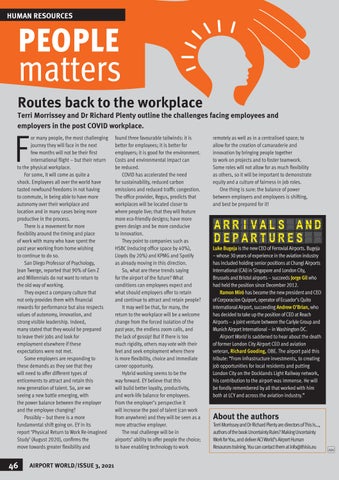HUMAN RESOURCES
PEOPLE
matters Routes back to the workplace Terri Morrissey and Dr Richard Plenty outline the challenges facing employees and employers in the post COVID workplace.
F
or many people, the most challenging journey they will face in the next few months will not be their first international flight – but their return to the physical workplace. For some, it will come as quite a shock. Employees all over the world have tasted newfound freedoms in not having to commute, in being able to have more autonomy over their workplace and location and in many cases being more productive in the process. There is a movement for more flexibility around the timing and place of work with many who have spent the past year working from home wishing to continue to do so. San Diego Professor of Psychology, Jean Twerge, reported that 90% of Gen Z and Millennials do not want to return to the old way of working. They expect a company culture that not only provides them with financial rewards for performance but also respects values of autonomy, innovation, and strong visible leadership. Indeed, many stated that they would be prepared to leave their jobs and look for employment elsewhere if these expectations were not met. Some employers are responding to these demands as they see that they will need to offer different types of enticements to attract and retain this new generation of talent. So, are we seeing a new battle emerging, with the power balance between the employer and the employee changing? Possibly – but there is a more fundamental shift going on. EY in its report ‘Physical Return to Work Re-imagined Study’ (August 2020), confirms the move towards greater flexibility and
46
AIRPORT WORLD/ISSUE 3, 2021
found three favourable tailwinds: it is better for employees; it is better for employers; it is good for the environment. Costs and environmental impact can be reduced. COVID has accelerated the need for sustainability, reduced carbon emissions and reduced traffic congestion. The office provider, Regus, predicts that workplaces will be located closer to where people live; that they will feature more eco-friendly designs; have more green design and be more conducive to innovation. They point to companies such as HSBC (reducing office space by 40%), Lloyds (by 20%) and KPMG and Spotify as already moving in this direction. So, what are these trends saying for the airport of the future? What conditions can employees expect and what should employers offer to retain and continue to attract and retain people? It may well be that, for many, the return to the workplace will be a welcome change from the forced isolation of the past year, the endless zoom calls, and the lack of gossip! But if there is too much rigidity, others may vote with their feet and seek employment where there is more flexibility, choice and immediate career opportunity. Hybrid working seems to be the way forward. EY believe that this will build better loyalty, productivity, and work-life balance for employees. From the employer’s perspective it will increase the pool of talent (can work from anywhere) and they will be seen as a more attractive employer. The real challenge will be in airports’ ability to offer people the choice; to have enabling technology to work
remotely as well as in a centralised space; to allow for the creation of camaraderie and innovation by bringing people together to work on projects and to foster teamwork. Some roles will not allow for as much flexibility as others, so it will be important to demonstrate equity and a culture of fairness in job roles. One thing is sure: the balance of power between employers and employees is shifting, and best be prepared for it!
Luke Bugeja is the new CEO of Ferrovial Airports. Bugeja – whose 30 years of experience in the aviation industry has included holding senior positions at Changi Airports International (CAI) in Singapore and London City, Brussels and Bristol airports – succeeds Jorge Gil who had held the position since December 2012. Ramon Miró has become the new president and CEO of Corporacíon Quiport, operator of Ecuador’s Quito International Airport, succeeding Andrew O’Brian, who has decided to take up the position of CEO at Reach Airports – a joint venture between the Carlyle Group and Munich Airport International – in Washington DC. Airport World is saddened to hear about the death of former London City Airport CEO and aviation veteran, Richard Gooding, OBE. The airport paid this tribute: “From infrastructure investments, to creating job opportunities for local residents and putting London City on the Docklands Light Railway network, his contribution to the airport was immense. He will be fondly remembered by all that worked with him both at LCY and across the aviation industry.”
About the authors Terri Morrissey and Dr Richard Plenty are directors of This Is…, authors of the book Uncertainty Rules? Making Uncertainty Work for You, and deliver ACI World’s Airport Human Resources training. You can contact them at info@thisis.eu
AW















